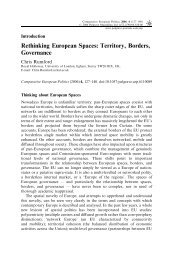Europeanisation, National Identities and Migration ... - europeanization
Europeanisation, National Identities and Migration ... - europeanization
Europeanisation, National Identities and Migration ... - europeanization
You also want an ePaper? Increase the reach of your titles
YUMPU automatically turns print PDFs into web optimized ePapers that Google loves.
126 Willfried Spohn<br />
‘small-Polish’ solution <strong>and</strong> the resulting ethnic <strong>and</strong> cultural diversity stood in sharp<br />
contrast to a culturally more homogeneous <strong>and</strong> politically more stable nation-state<br />
(Krzeminski 1991; Tomaszewski 1993).<br />
As neighbouring countries <strong>and</strong> with considerably overlapping populations, the<br />
construction of culturally homogenous nation-states in Germany as well as Pol<strong>and</strong><br />
included structural problems that became manifest in constant German–Polish<br />
tensions <strong>and</strong> conflicts throughout the nineteenth century <strong>and</strong> culminated finally<br />
in the catastrophe of the twentieth century (Kobylinska et al. 1992). These tensions<br />
<strong>and</strong> conflicts did not however develop on equal terms, but were characterised by<br />
growing structural asymmetries between the two evolving nations. The annexation<br />
of Polish l<strong>and</strong>s by Prussia <strong>and</strong> Habsburg Austria was the crucial starting point<br />
of these asymmetries. But in addition, these asymmetries were sharpened over time<br />
by the growing East–Western European socio-economic <strong>and</strong> political unevenness.<br />
This was particularly true for the relationship between Prussia <strong>and</strong> Polish l<strong>and</strong>s.<br />
After the dissolution of the German-Roman Empire, it was precisely Prussia that<br />
evolved as the most powerful territorial state in the German regions <strong>and</strong> became<br />
the new political leader for German unification by replacing the traditional<br />
Habsburg centre. This political leadership was based not only on the Western<br />
extension of Prussia into Germany with the Vienna peace treaty in 1815, but<br />
also on the specific modernity of the Prussian state, combining an enlightened absolutism,<br />
a centralised state bureaucracy <strong>and</strong> a modernising reform policy that<br />
promoted economic development <strong>and</strong> capitalist industrialisation <strong>and</strong> on this basis<br />
was able to increase its military <strong>and</strong> political power (Nipperdey 1987, 1991; Wehler<br />
1987, 1995). This growing power of the Prussian state, on the one h<strong>and</strong>, enabled<br />
the unification of Germany. But on the other, the Polish regions were thus dominated<br />
<strong>and</strong> confronted with an increasingly powerful centre that made any political<br />
resistance to it correspondingly impossible.<br />
One of the crucial factors of this evolving military <strong>and</strong> political power hierarchy<br />
between German <strong>and</strong> Polish l<strong>and</strong>s was the economic development of Germany<br />
from a moderately backward economy to a leading economic core in Europe during<br />
the nineteenth century. Again, it was the mercantilist developmental policy of the<br />
Prussian state – created under the conditions of the particular backwardness<br />
of the Prussian l<strong>and</strong>s – that served as a major mechanism of German catchingup<br />
modernisation (Spohn 1995). Germany then even overtook first France (with the<br />
war won in 1870/71 <strong>and</strong> the annexation of Alsace-Lorraine), but later also Great<br />
Britain at the turn of the century on the basis of the growing economic potential<br />
of the new big industries. The Polish l<strong>and</strong>s, particularly in the Prussian zone,<br />
participated to a certain degree in this German–Prussian growth dynamic, but<br />
more in traditional textile <strong>and</strong> agrarian than in modern industrial production. As<br />
a consequence, the Polish regions – not much less developed at the times of their<br />
partition than the Prussian l<strong>and</strong>s – became more <strong>and</strong> more a backyard of the<br />
European <strong>and</strong> particularly German economy (Berend <strong>and</strong> Ranki 1982; Berend<br />
1995: 129–50). The economic asymmetry between Germany <strong>and</strong> Polish l<strong>and</strong>s<br />
grew continuously throughout the long nineteenth century <strong>and</strong> diminished only<br />
slightly in the inter-war period in the first half in the twentieth century.



